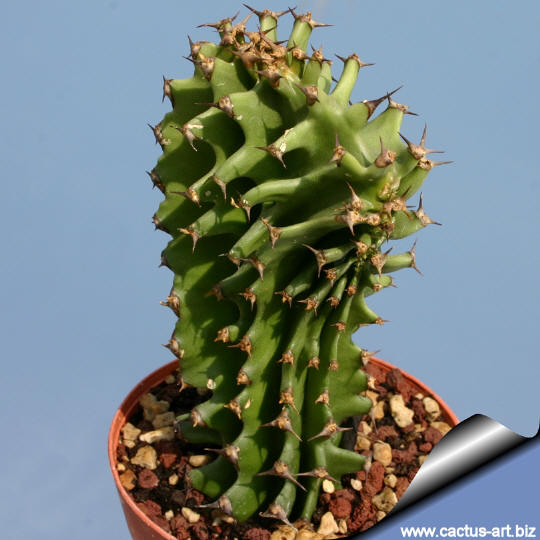|

Cultivation:
Euphorbia erythraea is an easy species to grow that is
suited for any well drained soil in full sun. But young plant are happy
growing indoors, where they can easily reach the ceiling. Give the plant
an airy growing medium which mainly consists of non organic material
such us clay, pumice, lava grit, and only a little peat or leaf-mould.
Water regularly during the active growing season from March to
September. No water should ever be allowed to stand around the roots.
Keep almost completely dry in winter. It is a moderately fast grower,
and will quickly become large landscape masterpieces in just 3-5 years.
Only downside is from strong winds, the columns often smash into each
other, causing permanent scarring... best to plant in such a location
where winds are not a big issue. If plant becomes very red, this is a
sign that the roots have not developed properly. It is a relatively fast
growing and long lived plant and once established, it will be content in
its position and with its soil for years. It can tolerate moderate
shade, and a plant that has been growing in shade should be slowly
hardened off before placing it in full sun as the plant will be severely
scorched if moved too suddenly from shade into sun. Like quite small
pots, repott in very later winter, early spring. Can be pruned for shape
and branching. Frost tender, frost free zones only.
Specific tips for growing the crested forms:
The crests are sometime grafted onto the standard columnar form but are
easily grown on their own roots. Any normal shoots should be removed to
promote the growth of the crest.
Propagation: Grafting or
cuttings. It is easy to propagate by cuttings in late spring to
summer, just take a cutting of the plant let it dry for 1 or 2
weeks and stuff it in the ground (preferably dry, loose, extremely well
draining soil). Cuttings will root only in hot weather. Cuttings must be
kept quite dry to root.
|